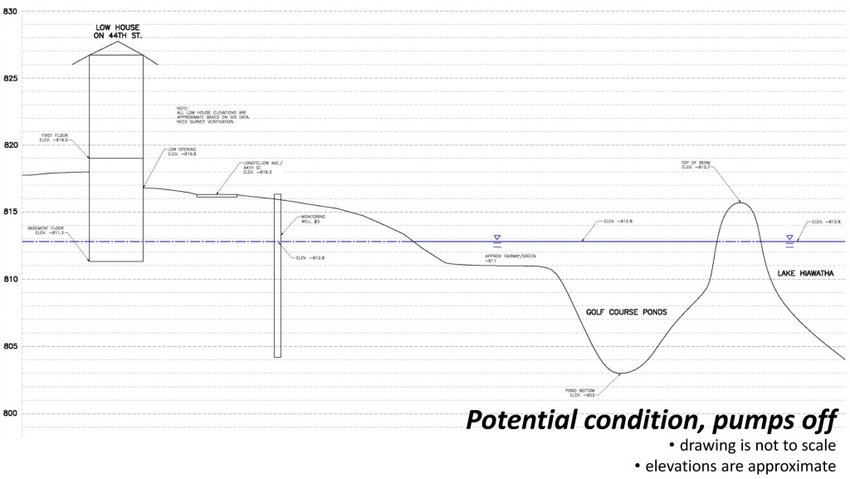
Turning off the pumps at Hiawatha Golf Course may flood 9-18 homes nearby.
This fact recently came to light as the Minneapolis Parks and Recreation Board (MPRB) struggles over how best to manage excess water at the course.
Currently, the pumps there are moving 263 million gallons of shallow groundwater each year from low land at the course into Lake Hiawatha, which is four feet higher and separated by a berm.
A small to medium-sized town uses this much water each year, pointed out MPRB Assistant Superintendent of Planning Michael Schroeder during a public meeting at Pearl Park on Tue., June 14.
The Minneapolis Parks and Recreation Board has been evaluating what to do at the golf course since a large amount of pumping was discovered last fall while planners were working to restore the golf course with FEMA funds.
 Photo left: Residents gathered to learn the fate of the Hiawatha Golf Course during a community meeting at Pearl Park on June 14. At the last meeting in September 2015, attendees learned that the golf course was pumping 263 million gallons of water a year from the course. On June 14, MPRB Assistant Superintendent of Planning Michael Schroeder told people that if the pumping were to stop, it might flood nearby homes. (Photo by Tesha M. Christensen)
Photo left: Residents gathered to learn the fate of the Hiawatha Golf Course during a community meeting at Pearl Park on June 14. At the last meeting in September 2015, attendees learned that the golf course was pumping 263 million gallons of water a year from the course. On June 14, MPRB Assistant Superintendent of Planning Michael Schroeder told people that if the pumping were to stop, it might flood nearby homes. (Photo by Tesha M. Christensen)
No decisions have yet been made on whether the pumping will continue, according to Schroeder.
However, the back nine, which had been closed since the flooding in July 2013, was reopened for play in mid-June 2016.
What are the basement elevations nearby?
How many homes and how severe the flooding would be is not something MPRB knows yet.
Staff began meeting in mid-June with affected homeowners to better understand the situation.
The current estimate of 9-18 homes is based on guesses regarding the basement levels of nearby homes in the area of 19th Ave. and 44th St., but planners have not yet gathered the figures of exactly how deep the basements reach.
Other areas nearby, such as along Cedar and Bloomington, may also be affected.
Tests show water on golf course likely to rise four feet
Since first informing the public about the large amount of pumping on Sept. 15, MPRB hired the neighborhood consulting firm, Barr Engineering, to conduct several tests. The initial contract was for $104,000. Plus there is the cost of staff time spent on this issue.
Initially, MPRB expected to have some answers within two to three months, but it took nine months to come back to the community, and they aren’t done yet.
Until then, MPRB has suspended its efforts to define what an improved golf course would look like.
Analysts have confirmed that the estimated amount of water being pumped from the course was accurate last fall.
Tests were conducted over the winter to see what would happen if the pumps at the course weren’t used anymore. From Dec. 31, 2015, to Jan. 4, 2016, the pumps were shut off, and the pond elevation increased one foot in 92 hours.
 Photo right: A citizen questioned whether the number of people interested in golfing was declining. Hiawatha Golf Course Superintendent Keith Kalny responded that he believes the numbers at Hiawatha declined in the past because of the course conditions. Today they’re working to keep the course in as good a condition as possible. “It’s a strong community golf course with a strong following,” Kalny said. “It’s a good gateway for new golfers to come to the game, as well.” (Photo by Tesha M. Christensen)
Photo right: A citizen questioned whether the number of people interested in golfing was declining. Hiawatha Golf Course Superintendent Keith Kalny responded that he believes the numbers at Hiawatha declined in the past because of the course conditions. Today they’re working to keep the course in as good a condition as possible. “It’s a strong community golf course with a strong following,” Kalny said. “It’s a good gateway for new golfers to come to the game, as well.” (Photo by Tesha M. Christensen)
The test suggests that without pumping, the water elevation on the golf course would equalize with Lake Hiawatha and rise four feet.
If that were to happen, basements nearby are likely to flood.
Analysts estimate that some nearby basements are at an elevation of 811.3, which falls below the 812 elevation of the lake. The street is at an elevation of 816.3, while the ponds are at 808.6.
The elevation of nearby Lake Nokomis, which is separated from the creek, is 816.
The top of Minnehaha Falls is roughly 800 feet above sea level.
“We understand what’s going on with the golf course,” said Schroeder.
“When we get off the golf course that’s what we’re trying to figure out now.”
Water being pumped in a circle
MPRB has been pumping stormwater and groundwater from ponds on the golf course into Lake Hiawatha since the 1960s.
The current pumping is more than a permit for 36.5 million gallons a year--or approximately seven times the permit allowance.
About 17 percent of the water is stormwater run-off, 33 percent is seepage directly from Lake Hiawatha and 50 percent is shallow groundwater.
“105 million gallons a year are being pumped in a little circle,” observed Schroeder. The water moves from the ponds into Lake Hiawatha and back into the ponds.
By pumping continuously for 72 hours, analysts concluded that the pumping at Hiawatha wasn’t negatively affecting the deep groundwater in the area. There was no change to the aquifer while 1.7 million gallons of water was pumped out on Feb. 16, 2016.
If pumping were to stop, most of the course would be underwater and it would be shut down. “We end up obliterating the golf course if water goes up to the level of the lake,” said Schroeder.
Commissioner Steffanie Musich stressed that this means that the park board would not be receiving any funds from the land to pay for management as it does now.
MPRB is still working with FEMA on the $1 million appropriation to restore the golf course after the 2013 flooding.
What is the cost of pumping?
What is the cost of pumping at Hiawatha? MPRB staff did not have an answer to that question.
The staff is considering whether pumping is ecologically sustainable and something the park board should do.
“We don’t know that it is bad, but we don’t know that it is good,” remarked Schroeder. He pointed out that MPRB’s resources to make any change are not unlimited.
While he said that the park board can no longer be sure that the golf course will continue to exist, he does think that “as long as we are pumping, we might as well have the golf course.”
Citizens have suggested that the lake be dredged to fix the problem. While dredging the lake would make it deeper, it wouldn’t lower the level because that is controlled by a high point in Minnehaha Creek downstream of the lake. Lowering the lake level would require permits and approvals from some or all of the regulatory agencies, including the Minnesota Department of Natural Resources, Minnehaha Creek Watershed District, the Federal Emergency Management Agency, and the Army Corp of Engineers. That would be difficult in Minnesota. Creek dredging would require the same permits and approvals.
Right now the ponds and the course provide additional water storage during a large rainstorm. Any changes made to that water storage will affect areas downstream.
Land use upstream of Lake Hiawatha has changed drastically in the last eight decades. What was once mostly forest, meadows, wetland and farms is now fully developed. This means that there is significantly more runoff to the creek and lake than in the past, causing the water elevations to rise more frequently, to higher elevations and for longer periods of time.
What this means is that the golf course is likely to flood again, and again require funds to fix.
Originally, the golf course was created by dredging the lake and using the fill to fashion a course.
This sort of thing would never be allowed today, remarked Schroeder.
It also may be why the golf course appears to be sinking, perhaps as much as a foot over the past few decades, according to long-time golfers. The heavy peat material from the lake is compacting the former wetland under the golf course so that the entire area is sinking. “We believe that the ground at the golf course will continue to sink,” said Schroeder.
What’s next?
Marcia Lewis appreciated the data and handouts presented at the June meeting. The information is also available on the MPRB website. “Thank you because now we have some information to build on,” Lewis stated.
MPRB is working to gather input from homeowners about the depths of their basements to discern the full impact on nearby homes if the pumping were to stop.
“The solution isn’t just about the golf course,” stressed Schroeder. He added, “We don’t intend to flood people out.”
Planners intend to consider alternative, more efficient, ways to how pumping is done at the course.
“We don’t have a solution,” said Schroeder. “We’re a long ways from making any decision on this.”
To share your input, email tpederson@minneapolisparks.org.
“In the long-term, what is the best, right answer?” Schroeder asked.
By TESHA M. CHRISTENSEN
Residents are frustrated that the city and the Minneapolis Parks and Recreation Board (MPRB) are waiting until all the studies are complete before a gate is installed to stop the trash flowing out of a stormwater pipe directly into the lake.
They are also concerned about other pollutants in the water.
According to MPRB Assistant Superintendent of Planning Michael Schroeder, the quality of the water being pumped from the course into the lake is about the same. This is based on a few water samples collected on Jan. 20, 2016.
 Photo left: Barb Terwey of the Friends of Lake Hiawatha complained about how trash is being handled at Lake Hiawatha. “I am not happy with answers I am getting from the city,” she said. (Photo by Tesha M. Christensen)
Photo left: Barb Terwey of the Friends of Lake Hiawatha complained about how trash is being handled at Lake Hiawatha. “I am not happy with answers I am getting from the city,” she said. (Photo by Tesha M. Christensen)
Those in attendance questioned the validity of water samples gathered in the middle of winter, and encouraged MPRB to sample for pollutants right after the course lawn has been treated with chemicals during the summer months.
The water was tested for phosphorus, as well as volatile organic carbons and diesel range organics.
Like much of the United States, the park board does not factor garbage in as an impairment to water bodies.
Volunteers, led by neighborhood resident Sean Connaughty, have been collecting one bag of trash each day from the lake. The majority is coming from a stormwater pipe on the northwest side that flows directly into the lake without a filter.
Connaughty does not want to see a trash solution delayed for 2-5 years while the MPRB studies the water issue at the golf course. “I get frustrated because I want to see a solution,” he said.
“I am not happy with answers I am getting from the city,” said Barb Terwey, a member of Friends of Lake Hiawatha.
Another resident brought up the dangers of pesticides to children and human health, citing recent scientific studies showing links to autism and other health problems.
Several residents pushed the city to come up with a temporary solution, a move supported by council member Andrew Johnson.
“I’ve been pushing for a temporary solution since the day we learned that a permanent solution is on hold until the pumping is figured out. And I agree with you all on the urgency,” he said publicly via the neighborhood e-Democracy Forum. “Staff committed to me this spring that they will work on engineering a solution for this summer, but made no guarantees.”
Johnson encourages residents interested in seeing a temporary solution to email him, which he will then share with staff to keep communicating the urgency.
Schroeder observed that water in Lake Hiawatha is there only about 4-11 days before it flows away down the creek. “We have some coming in from the park, but we have a whole lot coming in from the creek and stormwater,” said Schroeder.
He told residents that more analysis could be done.
Comments
No comments on this item Please log in to comment by clicking here